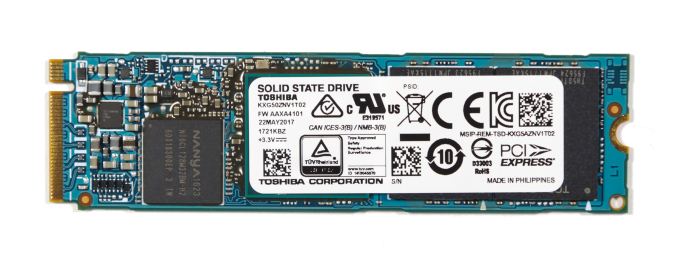The Toshiba XG5 (1TB) SSD Review
by Billy Tallis on August 3, 2017 9:01 AM ESTConclusion
The Toshiba XG5 isn't the fastest NVMe SSD; its use of TLC NAND and its reliance on SLC caching do hurt it in some scenarios, and Samsung's TLC-based 960 EVO is usually faster, sometimes by a wide margin. But for typical client and consumer workloads the XG5 offers very good mainstream performance that is competitive with many MLC-based NVMe SSDs. The drive that the XG5 most often ties with on performance is the Plextor M8Pe, which uses Toshiba 15nm planar MLC and a Marvell controller. Our M8Pe results are somewhat handicapped by our 512GB M8Pe sample being at a capacity disadvantage, but normally the use of TLC would be a bigger handicap.
Samsung's NVMe performance records are hard to beat, and Toshiba wasn't really trying for that with the XG5, though its performance is certainly good enough for the intended uses. Where Toshiba has raised the bar is power efficiency. The XG5 is one of the most power efficient PCIe SSDs on the market, in spite of using TLC NAND. Its efficiency is sometimes beat by some of Samsung's NVMe drives on tests that hit the XG5's most acute performance weaknesses, but on more real-world tests the XG5 is the clear winner.
As a successor to Toshiba's MLC-based OCZ RD400, the XG5 doesn't bring any significant performance improvement and is usually a bit slower. When Toshiba gets around to launching a true retail replacement for the RD400 we may see some modest performance increases due to firmware tweaks, possibly sacrificing some power efficiency in the process. For now as an OEM product, the XG5's advantages of lower cost, lower power consumption and a single-sided 1TB model are clearly worth the performance sacrifice.
We've had occasion in the past to complain about high-end laptops advertising NVMe SSDs but shipping with relatively disappointing TLC-based drives. The XG5 will not provide the same disappointment. Its performance is worthy of an expensive machine and its power efficiency makes it undoubtedly the best choice for OEMs to adopt.
In desktops or for laptops that don't really care about battery life, the XG5 is not an obvious winner and the decision comes down to pricing that isn't publicly available for OEM products. When Toshiba comes out with a retail counterpart to the XG5 it will not offer a significant performance upgrade over their OCZ RD400. Toshiba will have to position the retail counterpart as offering good NMVe performance at a much more accessible price that was possible with planar NAND. They should have no trouble offering a better price to performance ratio than drives using planar MLC and will have a much better value than drives like the Intel 600p and WD Black, but the real question is how much Toshiba can undercut the Samsung 960 EVO.
As with the Intel 545s, we see a new generation of 3D NAND flash bringing significant improvements, but not to the top-line performance numbers. In both cases we see substantially reduced power consumption and increased density. Since typical consumer workloads are not noticeably affected by further improvements in sustained performance at high queue depths, it looks like flash memory technology is moving in the right direction. These advances may be trickier to market to consumers than a 4GB/s throughput specification would be, but that doesn't make them any less valuable.











28 Comments
View All Comments
Billy Tallis - Monday, August 7, 2017 - link
We always try to get as many different capacities as possible. Some vendors are more willing than others to sample one of each size. Lately with the flash shortage, most vendors have been hesitant to send the full range of samples, and even after the product launches their PR teams have pretty limited sample availability.When I'm reviewing a single drive, I try to include primarily other drives from the same capacity class. If you want to compare eg. a 250 GB NVMe drive against a 512GB SATA drive, that's what our Bench database is for. (Though I haven't posted the 2017 results to Bench yet, and won't have time for that until after Flash Memory Summit.)
Bullwinkle J Moose - Thursday, August 3, 2017 - link
NewEgg insiders could buy the Samsung 850 Pro this week for $109 (256GB)A 10 year warranty on the Worlds Fastest consumer SATA drive turned out to be less expensive than a slower TLC drive with 3 - 5 year warranty then adding an extended warranty
Or you could just save $10 and get a slower TLC drive with a crappy warranty
Your choice
Kwarkon - Saturday, August 12, 2017 - link
Hi, you state that you have L1.2 enabled in your Idle powertest but clearly it is not working on your setup.I guess you use PCIe vertical to m.2 adapter and because of that you cannot go lower than L1.
SanX - Monday, August 14, 2017 - link
A year later and still 3x slower then Samsung 960 ? Why this company still exists?